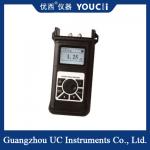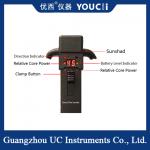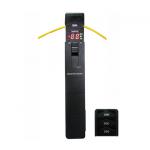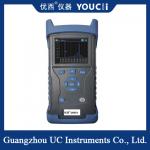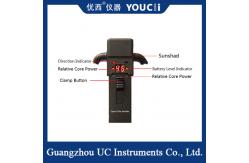The Handheld Optical Fiber Identifier Can Quickly Identify
Directions
The handheld optical fiber identifier achieves non-destructive
testing through macro bending technology and is a core tool for the
maintenance, installation and emergency repair of optical fiber
networks. Its high sensitivity, multi-functionality and portability
make it a "capable assistant" for communication engineers.
Specifications
Model# | U8652 | Identified Wavelength Range | 800-1700 nm | Identified Signal Type | CW, 270Hz±5%,1kHz±5%,2kHz±5% | Detector Type | Ø1mm InGaAs 2pcs | Adapter Type | Ø0.25 , Ø0.9, Ø2.0, Ø3.0 | Signal Direction | Left & Right LED | Singe Direction Test Range (dBm, CW/0.9mm bare fiber) | -46~10(1310nm) | -50~10(1550nm) | Signal Power Test Range (dBm, CW/0.9mm bare fiber) | -50~+10 | Signal Frequency Display (Hz) | 270, 1k, 2k | Frequency Test Range (dBm, Average Value) | Ø0.9, Ø2.0, Ø3.0
-30~0 (270Hz,1KHz) | Ø0.9, Ø2.0, Ø3.0
-25~0 (2KHz) | Ø0.25
-25~0 (1KHz,2KHz) | Ø0.25
-20~0 (2KHz) | Insertion Loss(dB, Typical Value) | 0.8 (1310nm) | 2.5 (1550nm) | Alkaline Battery(V) | 2pcs AAA batteries | Operating Temperature(℃) | -10-+60 | Storage Temperature(℃) | -25-+70 | Dimension (mm) | 196X30.5X27 | Weight (g) | 250 |
Application scenarios
Optical fiber installation and maintenance Optical cable splicing and emergency repair Optical fiber Resource management
Take stock of the usage status (in use/idle) of each fiber core in
the optical cable and optimize resource allocation.
When used in combination with OTDR (Optical Time Domain
Reflectometer), the fault points of optical fibers are located.
Data Center and Local Area Network maintenance
In a high-density optical fiber environment, quickly identify
specific optical fibers and simplify the maintenance process.
Detect the optical power attenuation of optical fiber links and
evaluate network performance.
|
